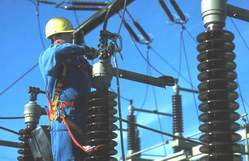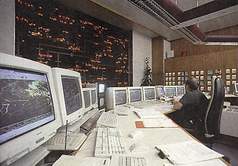 |
 |
|
We all want the wheels keep going. No one wants that
all at a sudden all wheels stop - all elevators are stuck - all
traffic lights are dark - all computers quit working and all lights
go out. But that is exactly what happens during a blackout, and
blackouts still happen. Thank heaven only once in a while but they
are still out there. Only because of the continuous efforts of an
elite group of engineers and technicians, working around the clock
with most sophisticated equipment, we are able to enjoy the amenities
of the 21st century without experiencing too often the inconvenience
of blackouts. The system that those engineers have to control and
maintain is one of the most complex systems one can imagine. Power
plants have sometimes to start up or shutdown in the matter of minutes
in order to maintain the very critical balance of demand and supply
in the nationwide electrical power network. |
| |
|
But what has this to do with RTA?
|
 |
|
Energy management is the process of monitoring and controlling
the cycle of generating, transporting and distributing energy.
Ideally consumers are near to the sites were power is generated,
but this is often impossible. This means, talking about electrical
energy that the energy needs to be transported from its generation
sites to the consumers via extensive transport networks. Usually
those networks spread over hundreds of miles. To ensure that those
transportation networks remain within the desired safety and economical
constraints, they are usually equipped with sophisticated Supervisory
Control And Data Acquisition systems
(SCADA) which help the operators to monitor and control the network.
|
| |
|
A SCADA system is a remote monitoring system that gives utilities
greater control over their electric power distribution network.
Utility operation centers can monitor and control all their substations
and other critical devices in their networks. SCADA systems are
usually operating on dedicated landlines connecting numerous remote
stations. The network's operation is monitored from a Dispatching
Control Room.
Whenever an unexpected event happens, hundreds or even thousands
of alarms are automatically sent to the control room by the SCADA
system. Under these circumstances the operator has to rely on
experiential knowledge to analyze the information, diagnose the
situation, and take appropriate actions to return the network
to a safe state.
|
 |
|
But the operator also needs proven and reliable tools that can
process all that information quickly, especially due to the huge
amount of information that arrives in a short period of time in
case of system faults. The data has to be processed in real-time
and the SCADA system has to provide the operator with the essential
information in very short time. Hence SCADA systems usually must
provide capabilities like
|
| |
|
- very fast data processing, in some cases this can mean processing
of a few thousand signals and messages per second
- fast screen switching, in emergency cases the operator must
be able to pull up the screens of affected regions in a few
seconds, and often those screens are very complex with a lot
of process data points
- data replication for redundancy and performance reasons (allowing
distributed computations)
- high availability, 24 hours a day / 7 days a week
- full redundant capabilities, this means MASTER / HOT-STANDBY
configurations
- open architecture for easy integration of 3rd party products
and scalability, i.e. SCADA systems are ideally based very much
on open standards like
- IEEE 802.3, IEEE 802.3.u (100Mb/s), TCP/IP
- ANSI C, IEC 61131-3
- OSF, POSIX
- SQL
|
| |
|
RTA - the powerful development tool for the new generation of
SCADA systems
|
 |
|
RTA is the perfect tool to meet these requirements. With its
real-time redundancy manager (RtRM) RTA provides all features
required to implement a maximum of safety, security and redundancy
by supporting MASTER - STANDBY (HOT-STANDBY) functionality with
automatic failover function. Its real-time database (RtDB) allows
real-time replication of all relevant process data on all RTA-nodes
in a network, thus allowing for distributed computing capabilities.
RtDB provides a tremendous read and writes performance due to
its sophisticated optimization algorithms. It provides all the
performance required by powerful SCADA systems.
The seamless integration of RTA with the ORACLE database and
its impressive synchronization mechanisms between RtDB and ORACLE
make RTA the ultimate tool for everyone who is seeking the performance
of a fast memory resident real-time database.
Another feature of RTA is the support different programming
languages. Even if it provides an own programming language, especially
designed for rapid implementation of distributed, redundant, real-time
applications. This language takes into consideration that RtDB
is an active database system and hence it supports ECA rules (Event
Condition Action rules). This allows for very easy customization
of the SCADA system.
And since RTA has an open architecture and allows effortless
integration of third party products, developers do not have to
reinvent the wheel again. Many SCADA systems of the new generation
are implemented using RTA.
|
|



